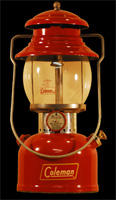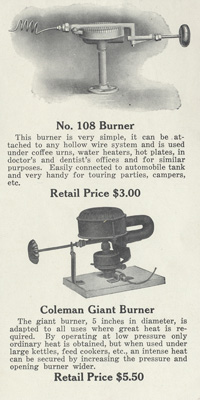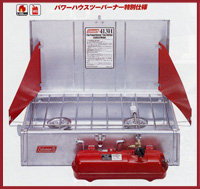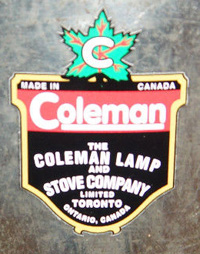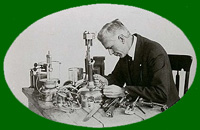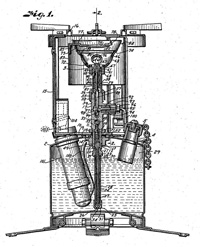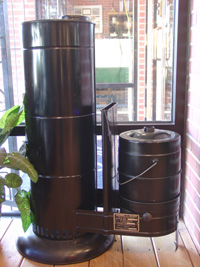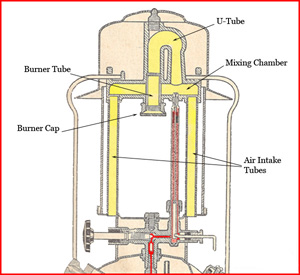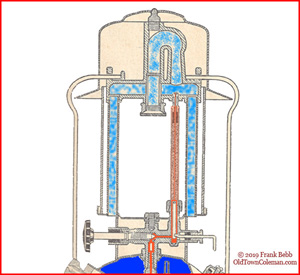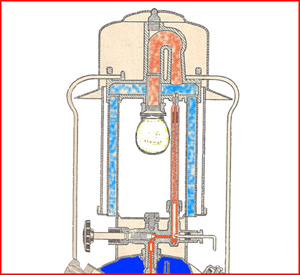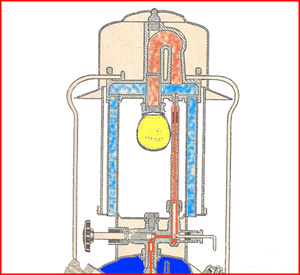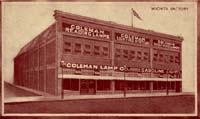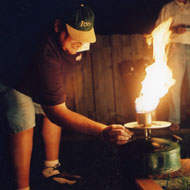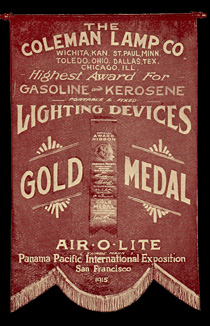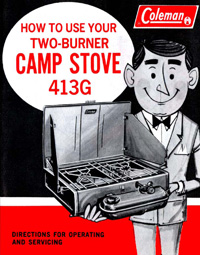 How Pressure Appliances Work
How Pressure Appliances Work
Part III: Making Light
Part Two discussed how the valve assembly works, then we moved pressurized fuel through the valve and generator up to the burner assembly. Now we can talk about the burner assembly, and how it produces light.
Figure 12 highlights the parts of a vintage single mantle lantern burner assembly. The burner for double-mantles and newer lanterns looks slightly different, but they operate the same manner. In a nutshell, the burner mixes fuel vapor with fresh air and burns the mixture to make the mantle(s) glow.
You'll notice that the generator gas tip is inside the mixing chamber. When fuel vapor shoots out the top of the gas tip, it is mixed with fresh air supplied by the air intake tubes. The air intake tubes are open at the bottom and some lanterns only have one, by design.
The light blue color in Figure 13 represents the fresh air circulating inside the mixing chamber. Directly above the generator is a hook-shaped tube, called the U-tube. The shape of this tube is critical and you'll find one on almost every pressure appliance Coleman® has ever made.
To the right of the U-tube is a choke point, an area where the inside diameter of the burner passage is the smallest. This is called a verturi and it increases the velocity of the air/vapor mixture passing through it. After the venturi, the air/vapor mixture reaches the U-tube where it is redirected 180°. The smooth round U-tube also produces a vortex which causes the mixture to spiral down towards the mantle at an increased speed.
Below the U-tube is the burner tube and the burner cap. The burner tube is simply a hollow tube that extends the mixing chamber while the burner cap is the device the mantle is attached to. The overall length of the mixing chamber (i.e. the distance between the gas tip and the burner cap) is engineered to deliver the correct air/fuel mixture. This is adjustable in many lanterns.
Figure 14 illustrates what we have just discussed. The generator is shooting hot vapor into fresh air and the mixing chamber. The mixture increases in velocity as it passes the venturi and is then redirected down to the mantle.
 And the final piece of our pressure lantern is the mantle. The mantle does two things for us. First, it creates a compartment that confines the gas vapor combustion to a small area. Secondly, it produces light. It does this because the flame inside causes certain chemicals to incandesce. The brilliant light you see is not fire; it is the mantle glowing.
And the final piece of our pressure lantern is the mantle. The mantle does two things for us. First, it creates a compartment that confines the gas vapor combustion to a small area. Secondly, it produces light. It does this because the flame inside causes certain chemicals to incandesce. The brilliant light you see is not fire; it is the mantle glowing.
The mantle is a small cloth envelope made from silk, rayon or other fabric material, and is saturated with various chemicals. Mantles cannot be used straight out of the packaging; they must be pre-burned. This burns away the fabric and leaves a very fragile ceramic shell that will incandesce when heated.
Prior to the early 1990s, Coleman® mantles were saturated with a solution of thorium and cerium nitrates. Thorium is a radioactive metal with an exceptionally high melting point and one that incandesces when heated. Modern mantles by Coleman® are impregnated with solution of yttrium, erbium and zirconium and are not radioactive. The safety trade-off most people accept is approximately 20% reduction in light using the yttrium mantle.
Figure 15 represents what we've been after this entire lesson--a lantern that is burning steady and bright. Let's quickly review so you can see how easy this really is
1. The fuel in our lantern is applied to the main valve, under pressure.
2. Opening the valve will allow the variable fuel/air mixture to enter the generator. A cold lantern will primarily burn the vaporized fuel inside the fount.
3. Vaporized fuel from the generator is mixed with fresh air in the mixing chamber. The inside diameter and shape of the U-tube causes the mixture to increase in velocity.
4. Vaporized fuel is ignited inside the mantle. This extremely hot flame will cause the chemicals in the Mantle to incandesce, which is what produces the light.
The main difference between lanterns and stove is their size. There are a few different names but the basic principals you have learned still apply.
![]() Part I: Creating and maintaining pressure
Part I: Creating and maintaining pressure
![]() Part II: Heating the fuel to create a gas vapor
Part II: Heating the fuel to create a gas vapor
![]() Part IV: Talking about stoves and burners
Part IV: Talking about stoves and burners


